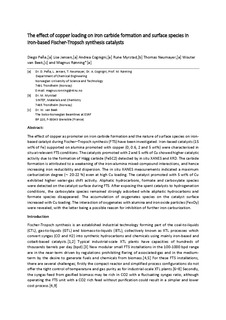The Effect of Copper Loading on Iron Carbide Formation and Surface Species in Iron‐Based Fischer–Tropsch Synthesis Catalysts
Pena, Diego; Jensen, Lise Saue; Cognigni, Andrea; Myrstad, Rune; Neumayer, Thomas; Van Beek, Wouter; Rønning, Magnus
Journal article, Peer reviewed
Accepted version

Åpne
Permanent lenke
http://hdl.handle.net/11250/2633230Utgivelsesdato
2018Metadata
Vis full innførselSamlinger
- Publikasjoner fra CRIStin - SINTEF AS [5802]
- SINTEF Industri [1566]
Sammendrag
The effect of copper as promoter on iron carbide formation and the nature of surface species on iron‐based catalyst during Fischer–Tropsch synthesis (FTS) was investigated. Iron‐based catalysts (15 wt % of Fe) supported on alumina promoted with copper (0, 0.6, 2, and 5 wt %) were characterised in situ at relevant FTS conditions. The catalysts promoted with 2 and 5 wt % of Cu showed higher catalytic activity due to the formation of Hägg carbide (Fe5C2) detected by in situ XANES and XRD. The carbide formation is attributed to a weakening of the iron–alumina mixed‐compound interactions, and hence increasing iron reducibility and dispersion. The in situ XANES measurements indicated a maximum carburization degree (ca. 20–22 %) even at high Cu loading. The catalyst promoted with 5 wt % of Cu exhibited higher water‐gas shift activity. Aliphatic hydrocarbons, formate, and carboxylate species were detected on the catalyst surface during FTS. After exposing the spent catalysts to hydrogenation conditions, the carboxylate species remained strongly adsorbed while aliphatic hydrocarbons and formate species disappeared. The accumulation of oxygenates species on the catalyst surface increased with Cu loading. The interaction of oxygenates with alumina and iron oxide particles (FexOy) were revealed, with the latter being a possible reason for inhibition of further iron carburization.
Beskrivelse
This is the accepted version of the following article: Peña, D., Jensen, L., Cognigni, A., Myrstad, R., Neumayer, T., Van Beek, W., & Rønning, M. (2018). The Effect of Copper Loading on Iron Carbide Formation and Surface Species in Iron‐Based Fischer–Tropsch Synthesis Catalysts. ChemCatChem, 10(6), 1300-1312., which has been published in final form at http://dx.doi.org/10.1002/cctc.201701673.